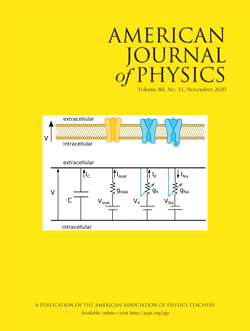 November 2020 Issue,
November 2020 Issue,
Volume 88, No. 11
Analog implementation of a Hodgkin–Huxley model neuron
We construct an electronic circuit for mimicking a single neuron's behavior in connection with the dynamics of the Hodgkin–Huxley mathematical model. Our results show that the electronic neuron, even though it contains binary-state circuitry components, displays a timing interplay between the ion channels, which is consistent with the corresponding timing encountered in the model equations. This is at the core of the mechanism determining not only the creation of action potentials but also the neuronal firing rate output. This work is suitable for educational purposes in physics, mathematical modeling, electronics, and neurophysiology and can be extended for implementation in networked neurons for more advanced studies of neuronal behaviors.
EDITORIAL
In this issue: November 2020 by Beth Parks. DOI: 10.1119/10.0002098
PAPERS
Analog implementation of a Hodgkin–Huxley model neuron by George H. Rutherford, Zach D. Mobille, Jordan Brandt-Trainer, Rosangela Follmann and Epaminondas Rosa Jr. DOI: 10.1119/10.0001072
A circuit that mimics the action potential and ion channels of a neuron is useful for both pedagogical and research purposes. The article presents a simple implementation of such a circuit, requiring only basic background in electronics and the physics of neurons.
Learning-assistant-supported active-learning in a large classroom by Vera Margoniner, Jérôme Bürki and Matthew Block. DOI:10.1119/10.0001699
Methods and results are presented from experiences using student learning assistants in active learning approaches to calculus-based mechanics at a public university, with evidence of greater learning gains. This work may be of interest to those considering changes in teaching methods.
Flight and bounce of spinning sports balls by Jacob Emil Mencke, Mirko Salewski, Ole L. Trinhammer and Andreas T. Adler. DOI: 10.1119/10.0001659
The motion of spinning sports balls is studied using a combination of analytical, numerical, and experimental techniques. Motion in both vacuum and air is considered, as well as flight and bouncing motion. Appropriate for undergraduates learning about projectile motion.
Collecting data with a mobile phone: Studies of mechanical laws such as energy and momentum conservation by Maximillian Hart and Mark G. Kuzyk. DOI: 10.1119/10.0001686
Mobile phone videos of pool-ball collisions yield rich data that can be analyzed in terms of not only the conservation of energy and momentum but also dissipative forces. Such experiments outside of campus can serve as a useful alternative when in-lab experiments are not practical.
Theoretical study of the geometrical non-linearity of the elastic properties of helical springs by Vladimir V. Ivchenko. DOI: 10.1119/10.0001696
By considering the torques from the force applied to a helical spring, a relationship of force and spring elongation is derived that goes beyond Hooke's law. This work can help undergrads beyond the first year appreciate nonlinearity.
Physical pendulum model: Fractional differential equation and memory effects by L. N. Gonçalves, J. Fernandes, A. Ferraz, A. G. Silva and P. J. Sebastião. DOI: 10.1119/10.0001660
The physical pendulum is studied with consideration of details related to hysteresis, entrainment of air mass, etc. Of particular interest is the use of fractional derivatives to represent memory effects. The material is most appropriate for advanced undergrads.
A completely algebraic solution of the simple harmonic oscillator by M. Rushka and J. K. Freericks. DOI: 10.1119/10.0001702
Landau levels, edge states, and gauge choice in 2D quantum dots by Asadullah Bhuiyan and Frank Marsigliov. DOI: 10.1119/10.0001703
Probability densities of quantum states ought to be gauge invariant, but this invariance can be hard to see. Eigenstates in both circular and square quantum dots in perpendicular magnetic fields are used to explore this gauge invariance, in a paper appropriate for upper-level undergraduate and introductory graduate level quantum mechanics instruction.
INSTRUCTIONAL LABORATORIES AND DEMONSTRATIONS
A LEGOTM dynamic force “macroscope” by D. Taylor, H. Smaje and P. Moriarty. DOI: 10.1119/10.0001700
Instructions are given for the low-cost construction of a macroscopic analog of an atomic force microscope that demonstrates many of the principles of AFM microscopy, using LEGOs, magnets and an Arduino microcontroller. The construction is a multifaceted laboratory experience for advanced undergraduates, and the device is useful for illustrating AFM in courses and in outreach.
Exploring delay dynamics with a programmable electronic delay circuit by Edgar Perez, Colleen Werkheiser, Alex Striff and Lucas Illing. DOI: 10.1119/10.0001695
Delay circuits enable the exploration of nonlinear effects and chaos, but existing circuits that can provide ∼100 ms delays are expensive or limited to AC signals. This paper, appropriate for advanced undergraduates, gives plans for a programmable delay circuit based on an Arduino Due and illustrates its use in exploring circuit dynamics.
Fluorescence lifetime measurements with simple correction for instrument temporal response in the advanced undergraduate laboratory by Eduardo Gonzalez, Seong J. Park and David M. Laman. DOI: 10.1119/10.0001752
Undergraduates can measure and correct for instrument response, allowing nanosecond luminescence lifetimes to be measured with standard equipment in the advanced laboratory.
NOTES AND DISCUSSIONS
A simpler graphical solution and an approximate formula for energy eigenvalues in finite square quantum wells by F. M. S. Lima. DOI: 10.1119/10.0001694
For the energy levels in a finite quantum square well, an approximation method is presented that is accurate even for very deep or shallow wells, only requires a pocket calculator, and is appropriate for an introductory quantum course.
Comment on “The negative flow of probability” [Am. J. Phys. 88, 325–333 (2020)] by Arseni Goussev. DOI: 10.1119/10.0001773
A recent AJP paper had shown that the flow of probability for a Gaussian wave packet can be in the direction opposite to that of the wave packet itself. In an analysis appropriate for a junior-level quantum mechanics course it is shown that this quantum effect is analogous to a classical effect.
BACK OF THE ENVELOPE
Energy cost of flight by Sanjoy Mahajan. DOI: 10.1119/10.0002140
This paper presents a simple model for the energy used in flight, understandable with only introductory mechanics. The lift and drag forces combine to yield a speed at which efficiency is maximized.
About AJP
General Information, Resources for Authors, Reviewers, and Readers

